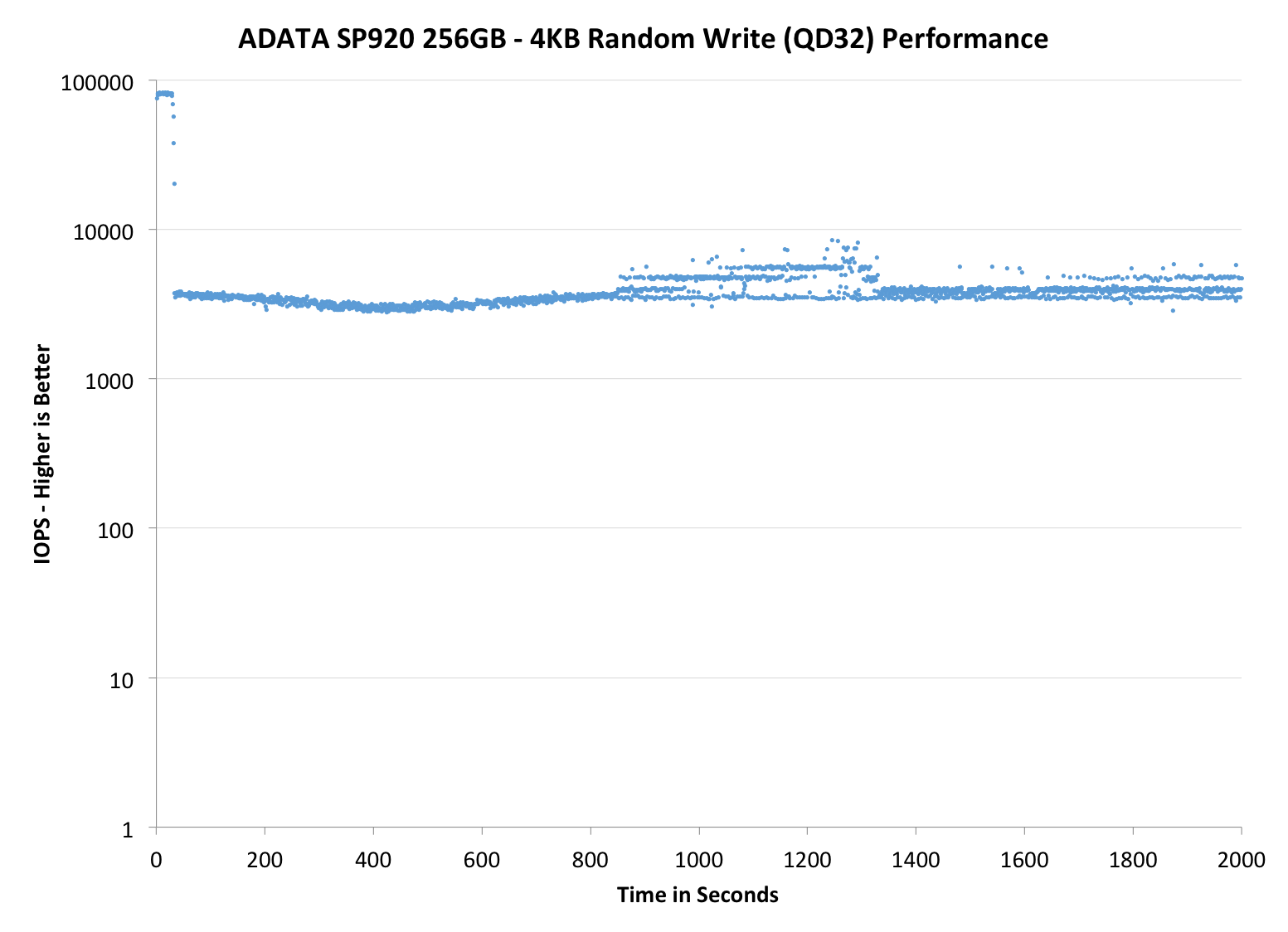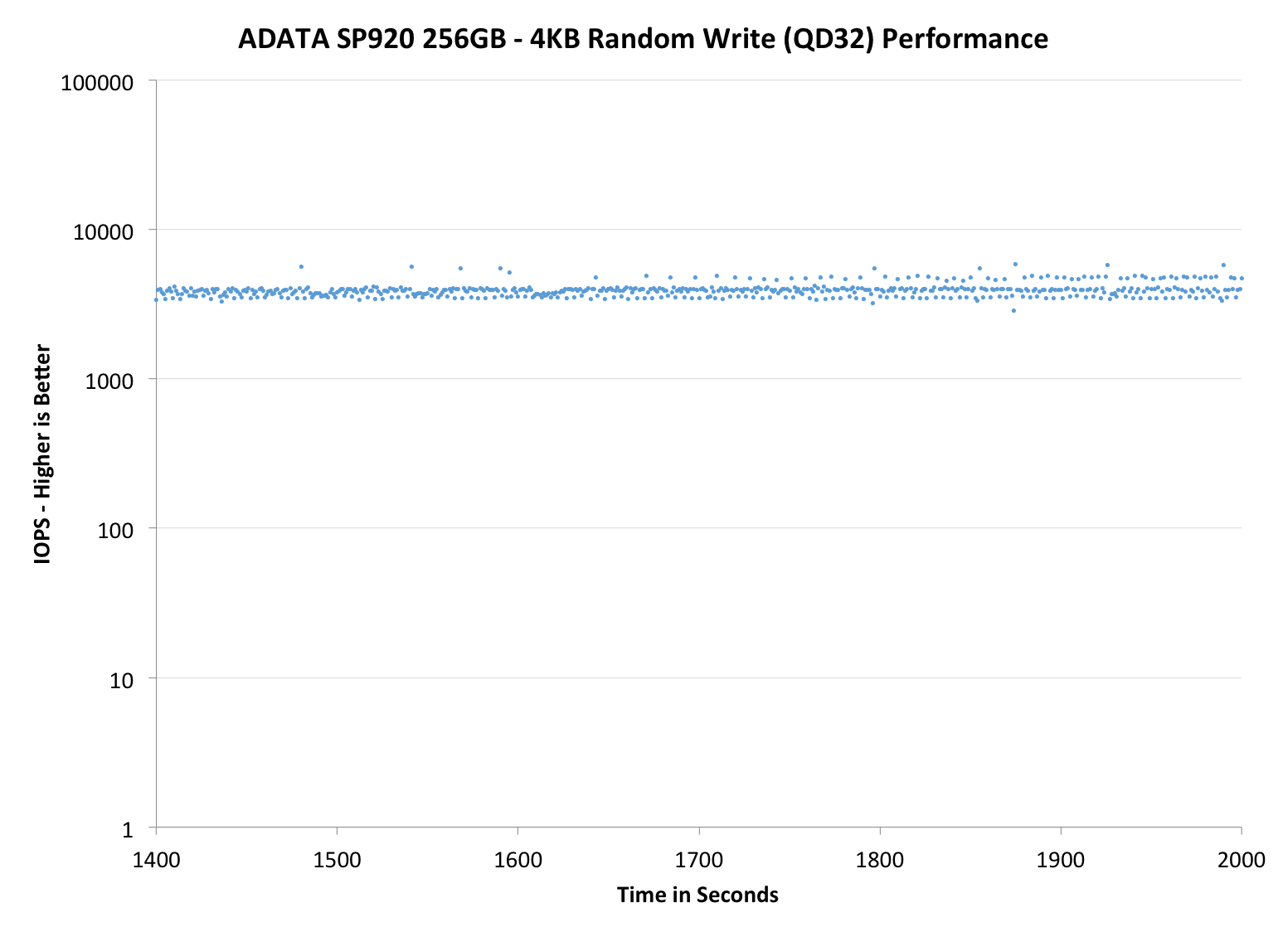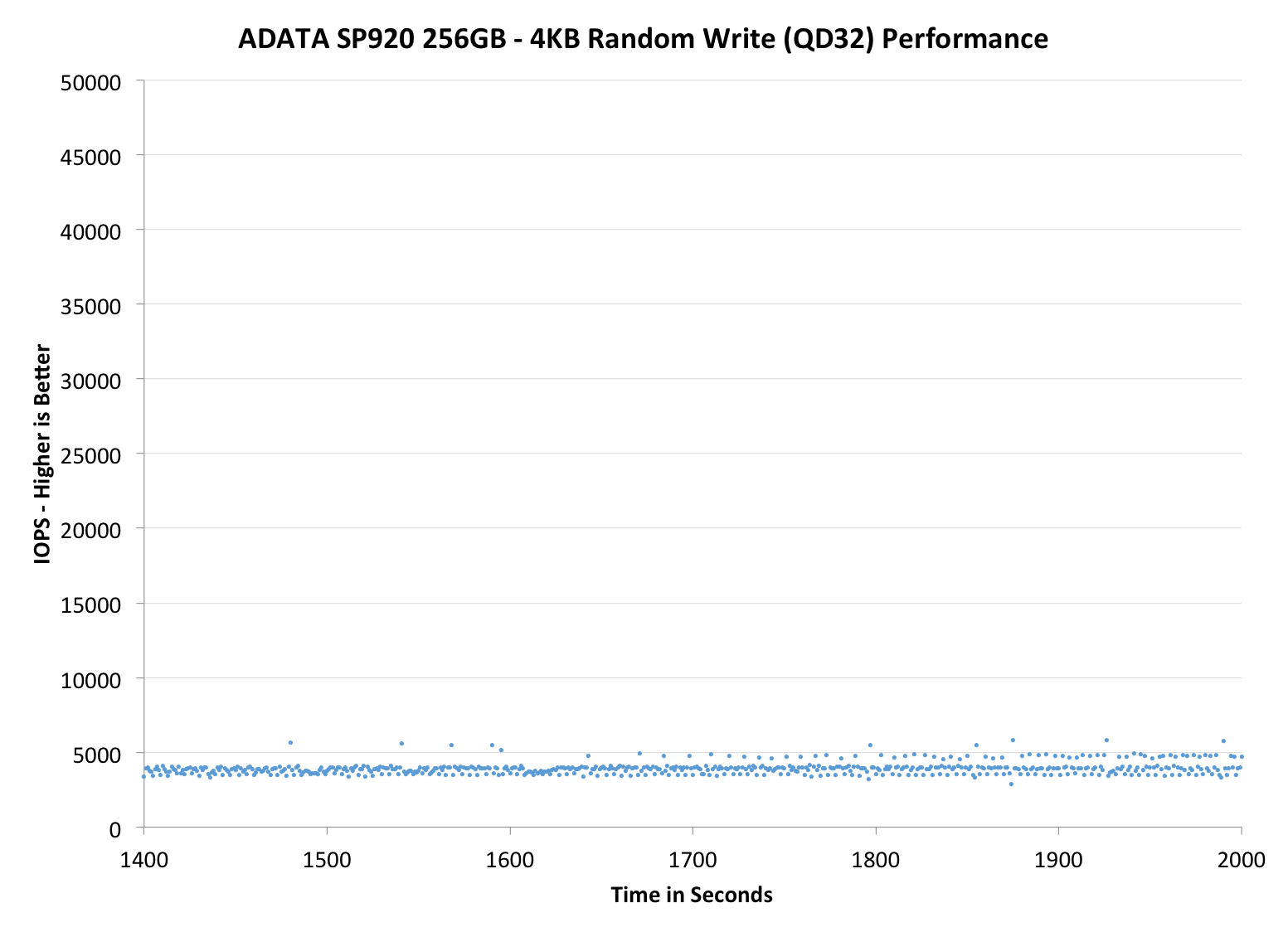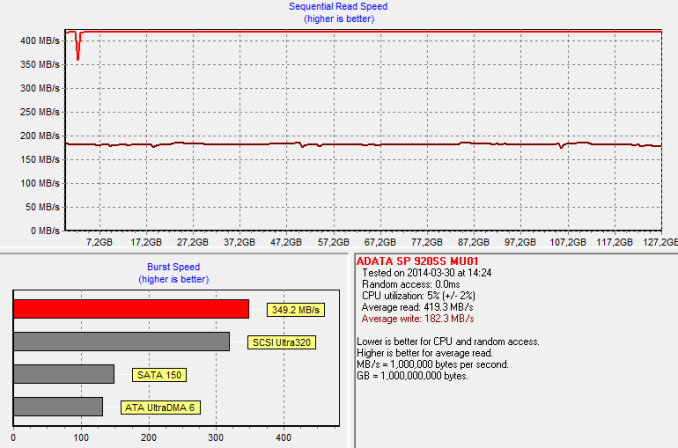ADATA SP920 (128GB, 256GB, 512GB & 1TB) Review
by Kristian Vättö on April 1, 2014 8:30 PM ESTPerformance Consistency
Performance consistency tells us a lot about the architecture of these SSDs and how they handle internal defragmentation. The reason we don’t have consistent IO latency with SSD is because inevitably all controllers have to do some amount of defragmentation or garbage collection in order to continue operating at high speeds. When and how an SSD decides to run its defrag or cleanup routines directly impacts the user experience as inconsistent performance results in application slowdowns.
To test IO consistency, we fill a secure erased SSD with sequential data to ensure that all user accessible LBAs have data associated with them. Next we kick off a 4KB random write workload across all LBAs at a queue depth of 32 using incompressible data. The test is run for just over half an hour and we record instantaneous IOPS every second.
We are also testing drives with added over-provisioning by limiting the LBA range. This gives us a look into the drive’s behavior with varying levels of empty space, which is frankly a more realistic approach for client workloads.
Each of the three graphs has its own purpose. The first one is of the whole duration of the test in log scale. The second and third one zoom into the beginning of steady-state operation (t=1400s) but on different scales: the second one uses log scale for easy comparison whereas the third one uses linear scale for better visualization of differences between drives. Click the buttons below each graph to switch the source data.
For more detailed description of the test and why performance consistency matters, read our original Intel SSD DC S3700 article.
 |
|||||||||
| ADATA SP920 | Crucial M550 | Intel SSD 730 | SanDisk Extreme II | Samsung SSD 840 EVO | |||||
| Default | |||||||||
| 25% Spare Area | - | ||||||||
As expected, the IO consistency is the same as in the M550 and even the capacity variations and over-provisioning behavior match. Like I said in the M550 review, I'm not very satisfied with the IO consistency compared to what we've seen lately but at least ADATA is positioning the SP920 as a mainstream value drive.
 |
|||||||||
| ADATA SP920 | Crucial M550 | Intel SSD 730 | SanDisk Extreme II | Samsung SSD 840 EVO | |||||
| Default | |||||||||
| 25% Spare Area | - | ||||||||
 |
|||||||||
| ADATA SP920 | Crucial M550 | Intel SSD 730 | SanDisk Extreme II | Samsung SSD 840 EVO | |||||
| Default | |||||||||
| 25% Spare Area | - | ||||||||
TRIM Validation
To test TRIM, I took a secure erased 128GB SP920 and filled it with sequential data. Then I tortured the drive with 4KB random writes (QD32) for 40 minutes followed by a TRIM command (quick format in Windows). Finally I measured performance with HD Tach to bring you the graph below:
And as you should expect, TRIM works.











30 Comments
View All Comments
Samus - Tuesday, April 1, 2014 - link
I'm just going to throw out there my experience with ADATA SSD's:S510: bricked in a year, but was near capacity which could have caused it to lock. however, no other SSD (sandforce or otherwise) has done that to me and this was used in an office PC with very little write activity.
SP900: Windows 7 BSOD after 5 months. had to secure erase and reinstall, did same thing 2 weeks later.
ADATA RMA takes forever (3 weeks each time.) The RMA form is erroneous and just getting the RMA number is a lot of back and forth. Proof of purchase, full system specs, lots of questions...the works. They try very hard to make it inconvenient, opposed to Crucial or Intel where the RMA process is "just send the drive to this address." They do mail back a new drive as a replacement, but don't offer to simply unlock a "frozen" drive, and obviously don't offer any sort of data recovery.
Considering I've never had a Crucial completely fail, or any issues whatsoever with an Intel drive, it's hard to ignore their reliability at the expense of 5-10% performance penalty.
Gigaplex - Wednesday, April 2, 2014 - link
Why would a parts warranty cover data recovery? That's what backups are for.Flunk - Wednesday, April 2, 2014 - link
I have a 256GB SX300 which is a Sandforce-based mSATA drive. I've had no problems and performance matches the review samples that were sent out.So my experience has been fine.
mikato - Wednesday, April 2, 2014 - link
No storage device manufacturers include data recovery service along with their devices. Data recovery usually costs more than the devices do. Some can refer you to a company that does it, and I know one has their own sub-company that does it, but it's completely separate from the device purchase. I'm curious what you mean by "simply unlock a "frozen" drive".By the way, SSD data recovery is usually quite a bit more difficult and more expensive than hard disk data recovery. And it's sometimes not even possible with more SSDs using encryption all the time, whether or not user specifies, and with the keys stored and decoding being done possibly in the part of the SSD that has failed (adios data).
If you're storing your data on an SSD (not just the OS, programs), you should be aware of the reduced avenues of disaster recovery and be even more careful with backups.
Samus - Wednesday, April 2, 2014 - link
ssd data recovery is quite simple actually, you just can't use traditional means to do it. Most if not all sad data recovery is accomplished by simply unlocking the drive or repairing the indirection table. Drives lock when they run out of spare area, good writable blocks, or can't trim/operate normally often occurring when they are low on capacity. Indirection table repair is more complex but on a file-by-file basic (lets say you just needed a few documents) it isn't very time consuming if the tech known what they are looking for.I've toured ontrack's Chicago lab and seen this all in action, they have a higher success rate with ssd's than HDD's (both over 99%)
I don't expect OEM's or manufactures to offer data recovery, but when data recover is a matter of plugging a drive in and unlocking it because their firmware is bricking drives, they SHOULD do it for their customers.
All those "refurbished" SSD's? What do you think those are? They're drives that have simply been unlocked and secure erased. It takes manufactures 30 seconds to do.
Go research sandforce "frozen" or "locked" and you'll see these controllers are notorious for locking drives (to the point they don't even detect in the BIOS) for various reasons.
hojnikb - Wednesday, April 2, 2014 - link
I've got s510 and so far so good (except bsods, i'm getting those on all my sandforce drives). As far as RMA is concernd, i've never had any issues. Last time i had to replace my usb drive, because it died on me (probobly bricked controller), they replaced it within days.Sabresiberian - Friday, April 4, 2014 - link
Despite your negative experiences, I wouldn't use them to determine that ADATA SSDs should be avoided. That being said, if I can get a 5-year warranty instead of a 3-year for very little more money I'll do that (yeah I know they are largely there to lower the worry factor for those that think SSDs might be less reliable, but still, if you need it, it's good to have). I just bought 2 480GB Sandisk Extreme IIs for $300 each - if you keep your eye out such discounts aren't hard to come by.Sabresiberian - Friday, April 4, 2014 - link
Looking at Newegg reviews, I see that ADATA drives get 3 or 4 stars. Sandisk gets 4 or 5 stars, no 3 stars. Not an absolute sign of quality of course, but over hundreds or thousands of comments from people that have bought these things, it is a factor to consider.iwod - Tuesday, April 1, 2014 - link
Do Marvell now offer much better default firmware? It was used to be the case Marvell controller were cheaper, not because of its inferior hardware but it provides very simply firmware that wasn't very highly performing. But it seems now the "default" performance behavior are pretty much all the same.Which makes me interested in the next round of SSD Controller. Do anyone have update on those from Sandforce, Marvell, etc?
JDG1980 - Wednesday, April 2, 2014 - link
My understanding was that Marvell didn't provide firmware at all - it's up to the vendor.Personally, I'd like to see a Marvell-based SSD with an open source firmware, even if the performance isn't quite as good as the best proprietary solutions.